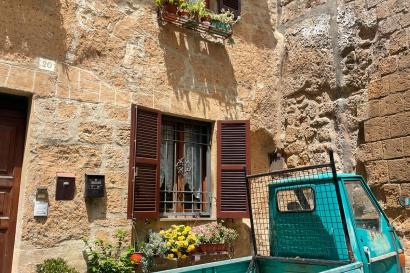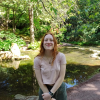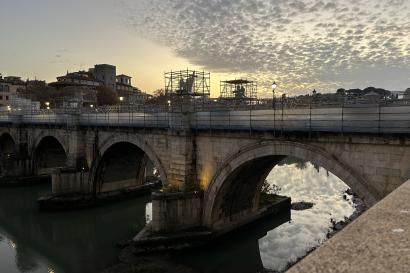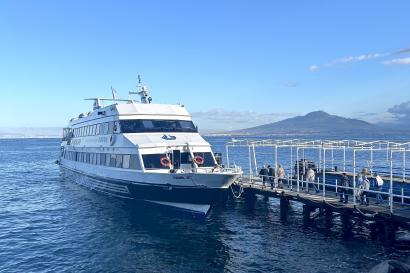After spending a full day walking around the city or visiting a famous monument or museum, you’re sure to work up an appetite, and the first thing you’ll want to do is find somewhere to sit, relax, and enjoy an aperitivo (drinks and light snacks) or meal. While it’s tempting to stop at the first restaurant you find outside of the attraction, you might notice that there are many places with large outdoor seating areas, large signs, and big, bolded menus (usually in English, and often also advertising with photos of their dishes). Since Rome is a popular tourist destination year-round, and especially during the summer, there are plenty of places that target foreign customers, and their proximity to such popular sites, especially tourist destinations with heavy pedestrian traffic, is intentional. Generally, I would recommend you to steer clear of these places that try to grab your attention by following these tips:
1. Ditch the Crowd!
As a rule of thumb, I would say that it’s best to avoid eating in crowded areas, especially at places where the hosts call out to you from the streets and attempt to usher you inside. These places are usually located along main roads, in a busy piazza, and close to popular tourist attractions around the city, such as Piazza Navona, Piazza di Trevi (location of the Trevi Fountain), Piazza della Rotonda (Pantheon), Piazza di Spagna (Spanish Steps) and the restaurants located immediately outside of the Vatican City and Vatican Museum entrances/exits. In these areas, you’ll be stuck paying for overpriced food and drinks from places that target foreign customers who are unaware of these business strategies, and the quality of your food will suffer the consequences as well. Similarly, I would be cautious of places that are currently trending on TikTok or Instagram, as they often have long queues full of tourists who found it just as appealing as it appeared online. I can’t speak to this experience because I haven’t visited any of these places, but I have had several friends advise me not to visit certain establishments because of the long waiting times and disappointment in the quality of their dish following their persuasion from another tourist on the internet. Instead, I would trust reviews from local customers online when deciding if these places are worth it to you!
2. Who Else Is Eating There?
Also, though it may be obvious, but if you’re wanting to try some authentic (and reasonably-priced) Italian dishes, one of the best determinants is by noticing the customers: if they’re mostly Italian, it’s more likely that you will enjoy a better meal. Some of the best places that I have dined at were located along small streets that I found while wandering and exploring the city without a destination in mind, which are usually frequented by locals who live nearby. Despite being small and unassuming, the hole-in-the-wall restaurants that I stumbled across never ceased to amaze me with their excellent renditions of classic Roman dishes, such as carbonara and cacio e pepe, and it is reassuring to know that they are enjoyed by native Italians, too.
3. Bar, Trattoria, Osteria, or Ristorante?
Depending on the time of day and your desired type of meal, your choice of where to dine may vary! In Italy, there is several different types of dining establishments or “restaurants”:
- Bar: small, casual places offering pastry items, sandwiches (panini), and light snacks, which are best to visit for breakfast or for an afternoon aperitivo between meals, and sometimes interchangeably called caffè
- Trattoria: often family-owned, informal restaurants with larger menus offering traditional and inexpensive dishes from the region
- Osteria: usually more formal and smaller than trattorias, offer smaller menus that are rotated depending on season and price, and primarily known for serving wines (different from enotecas, which only sell wine and offer tastings)
- Ristorante: more formal dining establishments, found in more central areas of the city and serve meals in courses, often slightly more expensive than other places
Of course, these are not strict definitions and this is not an exclusive list! However, if you’re new to dining in Italy, this simple breakdown can be incredibly helpful to understand when planning your meals dined out in the city. As someone who cooks the majority of my meals both at home and abroad, I’ve saved myself from disappointment when trying new places by knowing what to expect at these different types of places, and if you’re unsure, it is always a good idea to double-check online or ask others for recommendations in the area.
4. Speaking Italian Will Take You Places!
If you’re planning on studying abroad in Italy, even if you are not familiar with the Italian language, I cannot recommend enough that you use your dining experiences (as well as all other social interactions in public) as an opportunity to learn and practice speaking in another language! There’s truly no better place to learn a language than its place of origin, and talking with native speakers is a unique learning experience that will make you become more comfortable and confident as you continue to apply it in your daily life abroad.
Luckily, since Rome is a very popular tourist destination around the world, even if you don’t speak much (or any) Italian, many people speak English and are willing to help you. It’s still fun to try speaking Italian as you begin to pick it up and understand more, and when dining, not only will you familiarize yourself with useful words for food vocabulary, you will also be able to recognize and repeat conversational basics that you can use in many other social contexts. If you’re new to Italian and are afraid of having trouble reading things, some places also offer menus in English if you ask for one!
By using Italian, you’re given the gift of flexibility by being much more capable of finding and trying new places and foods enjoyed by locals. Besides, you’re much less likely to get swindled into a tourist trap if you’re able to understand the basics and are willing to stray from the comforts of large English menus and dining rooms full of other English-speaking customers. In this regard, I’d always advocate for taking chances and trying new things in order to have the most authentic dining experience as possible.
Final Thoughts
No matter your IES Abroad destination, it is important to learn about the culture and customs of your study abroad location, and dining may be a large factor in the cultural experience of a place. In this post, I want to share what I’ve learned from my experiences dining in Rome, especially if you’re someone who is unsure about how to identify tourist traps if you’re in search for a good meal abroad. Now, you should be ready to find a delicious new place to eat! Buon appetito!

Bailey Gregory
Hi, I’m Bailey! I’m from the mountains of western North Carolina and currently am a junior at UNC Chapel Hill studying Creative Nonfiction Writing and Art History. I love to read, and can usually be found fiddling in my garden or going for a walk.








